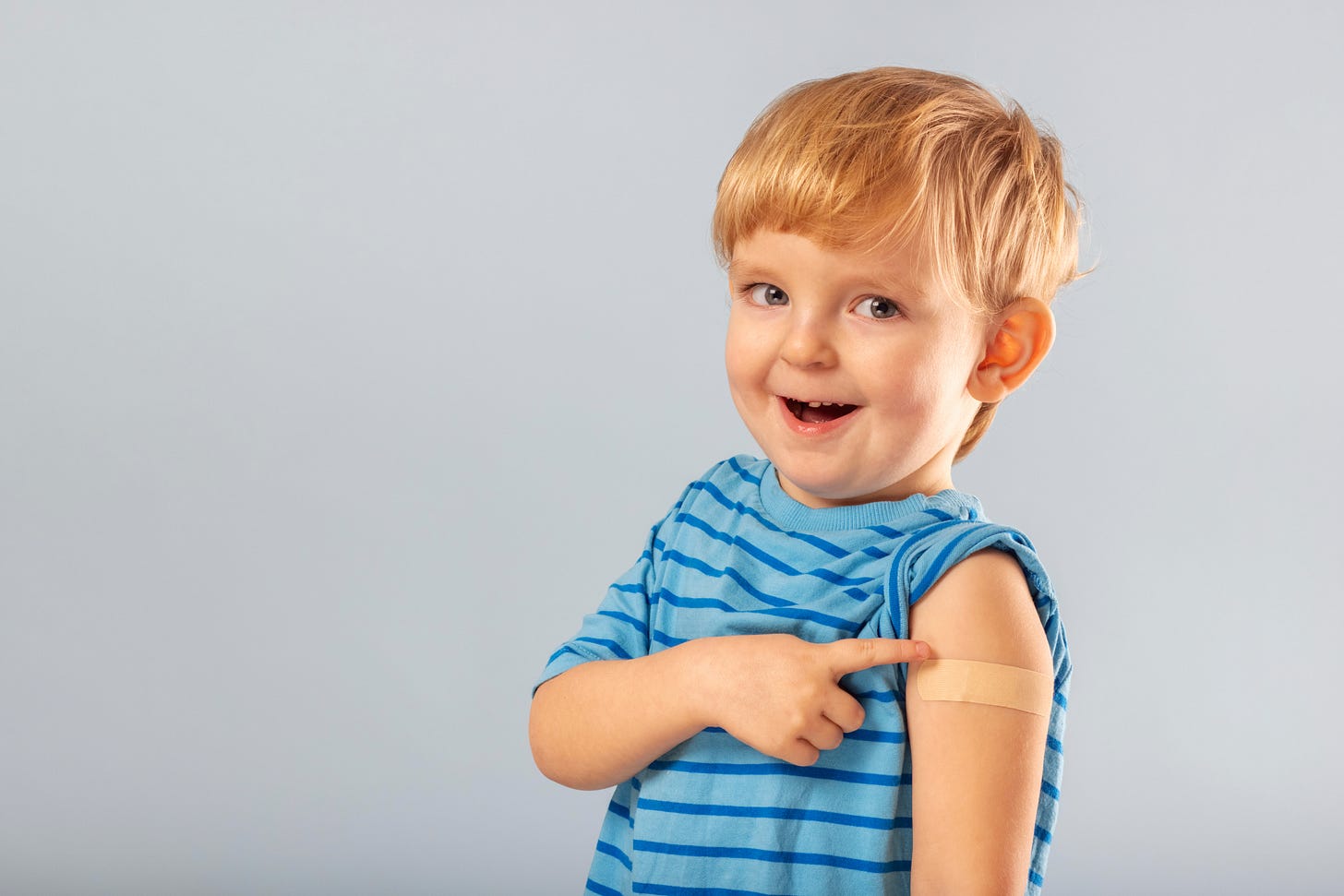Vaccines and Autism: The Wrong Question, the Right Conversation
Exploring how internal physiology, not blame, holds the key to understanding neurodevelopment.
Get weekly insights on how the modern world is reshaping childhood. Subscribe — it’s free.
Let’s dive into the persistent question that keeps emerging
Do vaccines lead to autism?
After twenty-five years of thorough research spanning the globe. Analysing various populations and employing diverse methodologies.
We can confidently assert
No.
The evidence is overwhelming: routine childhood vaccines do not elevate autism risk.
This is not a mere guess or a crafted message for public relations.
It’s a conclusion founded on the most robust forms of scientific evidence.
Even when researchers focus on vulnerable groups.
Premature infants, children with autistic siblings, or those with identified genetic vulnerabilities.
The results remain consistent.
The Evidence
There is no link.
This is not mere speculation or a soundbite for public consumption; rather, it is a conclusion drawn from the most robust scientific evidence.
Large-scale nationwide registry cohort studies involving 650,000 to 2 million participants found no association.
A meta-analysis of cohort studies covering 1.2 million individuals confirmed the same. High-risk sibling studies, involving around 95,000 children, also showed no link.
Even when examining the individual ingredients of vaccines through toxicological and pharmacological analysis, no connection to autism was found.
Across every type of study—population-level, familial, and ingredient-focused—the conclusion is the same: vaccines do not cause autism.
Importantly, the immune response triggered by a vaccine like MMR is negligible compared to the full-body inflammatory storm produced by the diseases they guard against.
Measles, for instance, can elevate IL-6 levels a hundredfold beyond what any vaccine could induce.
Equating the two is biologically incoherent.
So why does vaccine anxiety persist?
Because many parents have experienced moments of regression.
Sudden changes in their child’s development following illness, stress, or, yes, even a jab.
They’re not imagining it.
But the event isn’t the cause.
The child’s underlying vulnerability—their internal imbalance or sensitivity—is what makes any trigger, however minor, feel seismic.
Vaccines don’t cause autism.
But they do happen to show up in the same developmental window when some children’s systems are already nearing a tipping point.
It’s time we stop confusing correlation with causation—and start understanding the real biology behind regression.
When Immune Activation Does Matter
Vaccines may not cause autism, but that doesn’t mean immune activation isn’t important.
In reality, there are three significant instances where inflammation affects neurodevelopment, leaving lasting impacts.
Maternal Immune Activation (MIA)
When a mother’s immune system is activated during pregnancy by viral infections, prolonged fever, or chronic stress, the fetal brain can be profoundly affected.
In the fascinating realm of living beings, there are certain powerful messengers known as cytokines, such as IL-6 and IL-17A, that can profoundly impact the development of our brains.
Particularly in the regions that shape our ability to form social connections.
Strikingly, studies involving humans reveal that when mothers endure illnesses like the flu or a fever during their second trimester of pregnancy, the risk of their child developing autism significantly increases.
This connection highlights the importance of maternal health.
And its lasting effects on future generations, making it crucial for us to pay attention to these influences on our children’s lives.
Postnatal Inflammation
When a child is born too early or faces infections early on, their immune system can go into overdrive.
This persistent, low-level inflammation can disrupt the way genes function, especially those responsible for forming connections in the brain, known as synapses.
So, what does this mean for the child?
It can lead to significant changes in how their brain handles sensory information, emotions, and social interactions.
Essentially, this reveals the close connection between our health and development, highlighting a profound and complex relationship.
Gene × Environment Synergy
Children with a high genetic risk often struggle more when facing environmental stress.
During crucial stages of development, if inflammation occurs, it can activate certain genes, such as SHANK3, MEF2C, and CNTNAP2.
Now, unless you're a geneticist—or just really into alphabet soup—that probably doesn’t mean much.
But trust me: these genes are a big deal.
Think of them as the foremen on the brain’s construction site.
If they are activated at the wrong time or in the wrong way, the entire wiring plan can go awry.
You don’t need to memorise them—just know that when inflammation messes with these guys, it’s like letting toddlers rewire the house..
When these genes are activated, they can influence brain development, resulting in difficulties with flexibility and balance.
This underscores the profound relationship between our biology and the environment we inhabit.
Let us examine how different immune challenges accumulate and compare in their biological impact.
Severe infections during the foetal or neonatal period can trigger peak levels of inflammatory cytokines such as IL-6 and IL-17 in the range of 100–1000 pg/mL,
This is often accompanied by fevers that last for days to weeks.
These events are associated with long-term epigenetic effects on neurodevelopment.
In contrast, routine vaccinations—administered after six weeks of age—induce only mild immune activation, with cytokine peaks typically between 1–10 pg/mL
Fevers, if any, resolve in less than 24 hours.
To date, no long-term epigenetic effects have been detected from routine vaccines.
The difference in magnitude, timing, and duration of immune response clearly distinguishes the biological impact of infection from that of vaccination.
The verdict is clear: vaccines do not meet the biological threshold to trigger these effects.
What we should be talking about isn’t the vaccine, but the child’s underlying inflammatory tone.
The true “second hit” is the constant, subtle strain on our immune system.
This is where our attention must lie—on fostering prevention, building resilience, and ensuring early stabilisation.
Emergence – You really need to understand this.
When we say cognition is emergent, we mean it doesn’t come from one single thing.
Instead, it builds itself over time, shaped by everything around and inside you.
Think of it like this.
A cake isn’t just flour. Or eggs. Or sugar.
It’s what happens when you mix them in the right way, at the right temperature, for the right amount of time.
Your mind works the same way.
Genes are ingredients.
But the environment—your experiences, your emotions, your body’s signals—bakes the cake.
That’s emergence
The whole becomes something new that can’t be reduced to any one part.
Your thoughts, behaviours, and abilities aren’t pre-written.
They emerge from the interaction between your biology and your world.
Cognition Is Emergent — Not Encoded
It’s time we move beyond the outdated belief that cognition is written into our DNA like a script waiting to be read.
Cognitive outcomes—like academic performance, attention, or social behaviour—don’t unfold because of genes alone.
They emerge.
Emergence means that what we call a “mind” is shaped moment to moment by the interaction between biology and environment.
Nutrition, inflammation, caregiver stress, social touch.
The child’s internal physiological state (what we call the interostate).
Every synapse formed, every behaviour expressed, is a reflection of this dynamic.
It is not a genetic destiny.
Genome-wide association studies (GWAS) have identified thousands of genetic markers linked to educational attainment.
The largest of these studies, spanned over three million people.
The results?
Only about 4% of the variation in educational outcomes could be attributed to direct genetic effects.
But even that 4% is up for debate.
Because these “direct effects” are not truly universal.
They’re observed within a very particular context: a Western, industrialised, test-driven education system.
Change the context, alter the nutrition, the teaching model, the stress levels, the cultural expectations.
And then this so-called genetic “effect” begins to dissolve.
What appears to be genetic is, in fact, environmentally conditional.
Put simply, there are no genes for:
Intelligence. Autism. ADHD. Schooling. Anxiety.
There are only genes that respond to the conditions they’re embedded in.
Even the most “predictive” genes require an environment to shape their expression, and a nervous system tuned to receive them.
So let’s be clear.
Cognition is not fixed.
It is not downloaded from your DNA.
It is assembled in real time, sculpted by feedback between your biology and your world.
That is what it means for cognition to be emergent.
So let’s say it plainly.
There is no such thing as a gene for a neurotype.
There are only genetic sensitivities waiting to be shaped—or misshaped—by the environment they find themselves in.
Cognition is not fixed.
It is assembled in real time.
It is emergent
Interostate Equilibrium — The Missing Lens
To grasp why some children fall back after everyday happenings, don’t just focus on what set it off—shift your gaze to the surrounding landscape.
Every child’s mind continuously tunes into how they feel inside.
Their nervous system, using pathways called vagus and spinal afferents, keeps a close watch on:
Heart rate
Gut peptides
Cytokine levels
Hormonal rhythms
This continuous feedback loop generates a state of interoception—a real-time gauge of the body’s feelings of safety, stress, or danger.
When life is at its best and everything seems to say, "All systems normal!" our minds are free to explore, learn, and evolve.
But when danger lurks, we hear an alarming shout of "Threat!"
Our minds tighten up, and we feel trapped in familiar patterns.
We become extra sensitive and our attention narrows, blocking out the world around us.
It’s as if we lose our ability to adapt and react, hindered by fear instead of empowered by curiosity.
Autonomic flexibility is a crucial component of the TGTS model.
It’s all about how well we can switch between different ways of thinking depending on the situation we find ourselves in.
When this ability to adapt is lost, our behaviour can become stuck, reactive, or even overwhelming.
So what disrupts this equilibrium?
Low-grade inflammation (from gut dysbiosis or food sensitivities)
Chronic stress (from ACEs or environmental chaos)
Microbial metabolites (like propionic acid from disrupted microbiota)
Imagine a gentle push to a child's immune system, like the discomfort of teething, the common cold, or getting a vaccine.
For many children, these are just minor inconveniences.
But for a child whose body is already struggling, even these small challenges can turn into significant issues.
Potentially causing regression, emotional turmoil, or even a full shutdown.
It’s not about toxicity—it’s about thresholds.
This model explains three stubborn facts:
Vaccines often precede first-noticed regressions but show no causal link in population data.
Anti-inflammatory supports, such as omega-3s, sleep, and microbiome repair, can reduce autistic traits even after diagnosis.
Reduced heart-rate variability (HRV) is a biomarker for autism, ADHD, and anxiety, suggesting a shared autonomic bottleneck, not separate destinies.
In short, we’re not dealing with a binary switch (on/off autism).
We’re watching an orchestra slowly lose tune.
To truly make an impact, let’s move away from obsessing over individual triggers.
Instead, focus on nurturing and supporting the entire system.
Together, we can create meaningful change!
Environmental Levers Worth Our Attention
If vaccines aren’t to blame—what is?
The answer is not simple. It stems from the cumulative effect of numerous minor stressors that influence a growing system.
Unlike genetic predispositions, many of these factors can be changed or managed.
Let’s break them down.
Maternal & Perinatal Factors
Stress and trauma during pregnancy can raise cortisol and IL-6, impacting how the baby's brain develops.
Yet, with social support and mindfulness practices, we can ease these burdens, nurturing both mother and child towards healing and growth.
Air pollution and pesticides (e.g. PM₂․₅, organophosphates).
One of the lesser-known but important factors affecting a baby’s brain development is the quality of the air their mother breathes during pregnancy.
Air pollution contains tiny particles known as PM₂.₅, so small that they can be inhaled deep into the lungs and even cross the placental barrier.
These particles often come from car exhaust, industrial activity, wood burning, and general urban smog.
Studies have shown that when a pregnant woman is exposed to even slightly higher-than-average levels of this pollution, not extreme levels, just moderately worse than usual, the risk of her child later being diagnosed with autism increases by approximately 10%.
This kind of increase is based on what scientists call an "interquartile range" shift, which simply means moving from cleaner air to somewhat more polluted air within a typical urban environment.
The baby’s brain is especially sensitive during development.
Exposure to air pollution during this time may trigger inflammation or stress responses in the mother’s body that affect how the brain wires itself.
While air pollution alone doesn't cause autism, it appears to add to the overall load on the developing system.
When combined with other factors, such as genetic risk, poor nutrition, or emotional stress, it may tip the balance.
In short, cleaner air during pregnancy isn’t just good for lungs—it’s one of the many small but meaningful ways we can help give a child the best start in life.
Infancy
C-section births + early antibiotics reduce microbial diversity, raising inflammatory metabolites like propionic acid.
Ultra-processed diets for infants disturb the natural balance in our bodies, leading to harmful effects.
In contrast, whole foods create more transparent communication between the gut and the brain, fostering better health and wellness.
Early Childhood
Adverse Childhood Experiences paint a stark picture:
When a child grows up in an environment filled with abuse, neglect, or chaos, the likelihood of them developing traits linked to Autism Spectrum Disorder (ASD) rises dramatically.
This harsh truth is not limited to the U.K.; it resonates deeply across the U.S. as well, where numerous personal stories reveal the profound impacts of such difficult circumstances.
Socio-Economic Strain
Imagine a world where a child’s life is deeply influenced by their surroundings.
In areas where essential resources are scarce, children face enormous challenges to thrive.
On the other hand, when they are constantly monitored, their natural curiosity and sense of freedom can be stifled.
This unrelenting pressure can lead to serious consequences, as both scenarios contribute to a concerning rise in autism.
This underscores the vital role that our environments play in shaping a child's growth and overall well-being, each scenario presenting its own set of hurdles.
Our surroundings have a significant impact on the developing brain's ability to understand and respond to its own needs.
These risks are not just theoretical; they affect our mental health in real ways. However, let’s shift our perspective—this isn't about pointing fingers.
Instead, we should concentrate on creating a meaningful difference where it truly matters.
Rather than getting sidetracked by unfounded fears surrounding vaccines, let’s focus on the factors that genuinely impact us.
Clean air
Supportive caregiving
Microbiome diversity
Food quality
Emotional safety
This isn’t about controlling every minute detail; it’s about safeguarding our environment. We want to ensure that minor disturbances, like fevers, stress, and even vaccines, don’t throw everything into disarray.
Practical Actions for Parents & Policymakers
Let’s move from theory to action.
Stress affects the development of the nervous system.
Autism, is a potential outcome.
Then our mission is clear.
We must alleviate those pressures, particularly during the crucial early years of life.
Here are high-yield steps, backed by evidence and biologically plausible mechanisms.
Pregnancy Action
Get flu and Tdap vaccines
Prevents severe infections that trigger MIA (Maternal Immune Activation)
Support mental health (e.g. anxiety treatment, social support)
Reduces cortisol and IL‑6, protecting foetal brain circuits
Monitor and supplement vitamin D, iron, and choline
Critical for neurodevelopment and immune balance
Infancy
Encourage breastfeeding
Seeds’ microbiome diversity and supports gut-immune integrity
Use antibiotics judiciously
Prevents unnecessary microbial disruption in critical windows
At Home
Prioritise sleep hygiene and routines
Sleep stabilises inflammatory tone and cognitive flexibility
Improve indoor air quality (e.g. HEPA filters)
Lowers exposure to PM₂․₅, which crosses into the brain
Offer whole, minimally processed foods
Reduces gut permeability and supports brain-gut signalling
In the Community
Green spaces and outdoor play
Boosts heart-rate variability (HRV) and vagal tone through movement
Urban pollution controls near nurseries
Reduces known neurotoxic exposures like diesel particulates
Policy Level
Support maternity wellness programs
Prevents prenatal stress from cascading into child risk
Regulate high-risk pesticides (e.g. organophosphates)
These compounds are neuroactive and disproportionately affect children
Here’s the key point: None of these steps conflict with vaccination.
Vaccines play a crucial role in protecting our children from severe inflammation.
Take measles, for example—it can cause a spike in harmful substances in the body, over 100 times more than what occurs after an MMR vaccine.
By preventing these intense inflammatory responses, we safeguard not only their health but also their brain development.
Call to Action: From Blame to Balance
Autism research is evolving.
The “one-cause” era, where we chased single villains like vaccines, is over.
The data compel us to shift the conversation.
Away from blame. Toward balance.
When a child acts out, it often shows what's happening inside them.
For these children, it’s important to focus on their essential needs first.
This means ensuring they have a healthy gut and reducing any inflammation in their bodies.
Creating a safe environment for them, providing predictability in their daily routines, and ensuring they get enough sleep.
By meeting these fundamental needs, we can help calm their emotions and improve their behaviour overall.
Vaccination isn't something to fear; it’s one of our best shields against serious infection and subsequent inflammation.
Remember how diseases like measles, rubella, and polio used to devastate lives?
We faced those challenges head-on, and together we conquered them!
It's crucial to hold onto the lessons we learned and the victories we’ve achieved against these once-dreaded illnesses.
Every vaccine is a step toward protecting our health and ensuring a brighter future for everyone.
But now, we face new 21st-century headwinds:
Microbiome depletion
Chronic low-level pollution
Emotional dysregulation
Ultra-processed diets
Socioeconomic precarity
These are the real storms swirling through the lives of young children today.
Let’s meet them with the same resolve we once brought to infectious disease.
Let’s build a world where every child’s nervous system has the chance to tune itself in harmony with its body, its environment, and the people who care for it.
That’s how we protect the orchestra.
That’s how we keep the music playing.







